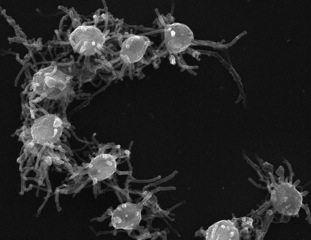Related Research Articles

Nucleariida is a group of amoebae with filose pseudopods, known mostly from soils and freshwater. They are distinguished from the superficially similar vampyrellids mainly by having mitochondria with discoid cristae.

Lobosa is a taxonomic group of amoebae in the phylum Amoebozoa. Most lobosans possess broad, bluntly rounded pseudopods, although one genus in the group, the recently discovered Sapocribrum, has slender and threadlike (filose) pseudopodia. In current classification schemes, Lobosa is a subphylum, composed mainly of amoebae that have lobose pseudopods but lack cilia or flagella.

The tectofilosids are a group of filose amoebae with shells. These are composed of organic materials and sometimes collected debris, in contrast to the euglyphids, which produce shells from siliceous scales. The shell usually has a single opening, but in Amphitrema and a few other genera it has two on opposite ends. The cell itself occupies most of the shell. They are most often found on marsh plants such as Sphagnum.

The Tubulinea are a major grouping of Amoebozoa, including most of the more familiar amoebae genera like Amoeba, Arcella, Difflugia and Hartmannella.

Discosea is a class of Amoebozoa, consisting of naked amoebae with a flattened, discoid body shape. Members of the group do not produce tubular or subcylindrical pseudopodia, like amoebae of the class Tubulinea. When a discosean is in motion, a transparent layer called hyaloplasm forms at the leading edge of the cell. In some discoseans, short "subpseudopodia" may be extended from this hyaloplasm, but the granular contents of the cell do not flow into these, as in true pseudopodia. Discosean amoebae lack hard shells, but some, like Cochliopodium and Korotnevella secrete intricate organic scales which may cover the upper (dorsal) surface of the cell. No species have flagella or flagellated stages of life.
Gephyramoeba is a genus of heterotrophic amoebae, morphologically similar to genera Rhizamoeba and Leptomyxa, although it is not genetically related to either of these genera.

The Zoopagomycotina are a subdivision of the fungal division Zygomycota sensu lato. It contains 5 families and 20 genera. Relationships among and within subphyla of Zygomycota are poorly understood, and their monophyly remains in question, so they are sometimes referred to by the informal name zygomycetes.

Capsaspora is a monotypic genus containing the single species Capsaspora owczarzaki. C. owczarzaki is a single-celled eukaryote that occupies a key phylogenetic position in our understanding of the origin of animal multicellularity, as one of the closest unicellular relatives to animals. It is, together with Ministeria vibrans, a member of the Filasterea clade. This amoeboid protist has been pivotal to unravel the nature of the unicellular ancestor of animals, which has been proved to be much more complex than previously thought.

Breviata anathema is a single-celled flagellate amoeboid eukaryote, previously studied under the name Mastigamoeba invertens. The cell lacks mitochondria but has remnant mitochondrial genes, and possesses an organelle believed to be a modified anaerobic mitochondrion, similar to the mitosomes and hydrogenosomes found in other eukaryotes that live in low-oxygen environments.
Rhizamoeba is an Amoebozoa genus.
Korotnevella is a genus of Amoebozoa.
Vahlkampfiidae is a family of Heterolobosea.
Monopylocystis visvesvarai is a species of excavates, placed in the monotypic genus Monopylocystis, and belonging to the group Heterolobosea.

Vahlkampfia is a genus of amoeboids in Heterolobosea.

Cecil Clifford Dobell FRS was a biologist, specifically a protozoologist. He studied intestinal amoebae, and algae. He was a leading authority on the history of protistology.
Defretinella is a genus of parasitic alveolates of the phylum Apicomplexa.

An amoeba or ameba, often called an amoeboid, is a type of cell or unicellular organism which has the ability to alter its shape, primarily by extending and retracting pseudopods. Amoebae do not form a single taxonomic group; instead, they are found in every major lineage of eukaryotic organisms. Amoeboid cells occur not only among the protozoa, but also in fungi, algae, and animals.

Kraken is a genus of amoebae within the Cercozoa, containing the sole species Kraken carinae. These amoebae are characterized by a small round cell body and a network of thin and very long filopodia that can reach up to a mm in diameter. Kraken amoebae feed on bacteria and live in freshwater and soil systems.

Parvularia atlantis is a filopodiated amoeba which was isolated from a lake in Atlanta and deposited in the American Type Culture Collection (ATCC) under the name Nuclearia sp. ATCC 50694 on 1997 by TK Sawyer. It was classified under the genus Nuclearia and morphologically resembles to Nuclearia species, although it is smaller. Later it was determined that it phylogenetically belongs to a new nucleariid lineage., distantly related to Nuclearia and Fonticula genera –the other two previously described nucleriid genera–.

The sedolisin family of peptidases are a family of serine proteases structurally related to the subtilisin (S8) family. Well-known members of this family include sedolisin ("pseudomonalisin") found in Pseudomonas bacteria, xanthomonalisin ("sedolisin-B"), physarolisin as well as animal tripeptidyl peptidase I. It is also known as sedolysin or serine-carboxyl peptidase. This group of enzymes contains a variation on the catalytic triad: unlike S8 which uses Ser-His-Asp, this group runs on Ser-Glu-Asp, with an additional acidic residue Asp in the oxyanion hole.
References
- ↑ Charles J. O'Kelly; Jeffrey D. Silberman; Linda A. Amaral Zettler; Thomas A. Nerad & Mitchell L. Sogin (2003). "Monopylocystis visvesvarai n. gen., n. sp. and Sawyeria marylandensis n. gen., n. sp.: two new amitochondrial heterolobosean amoebae from anoxic environments". Protist . 154 (2): 281–290. doi:10.1078/143446103322166563. PMID 13677454.
- ↑ Sutherland Maciver. "The Amoebae". University of Edinburgh . Retrieved June 25, 2009.
| This Amoebozoa-related article is a stub. You can help Wikipedia by expanding it. |